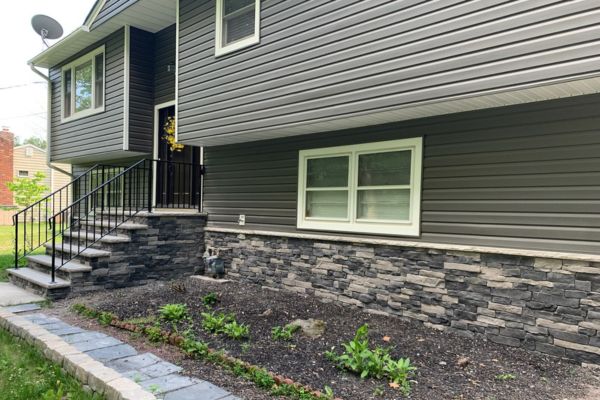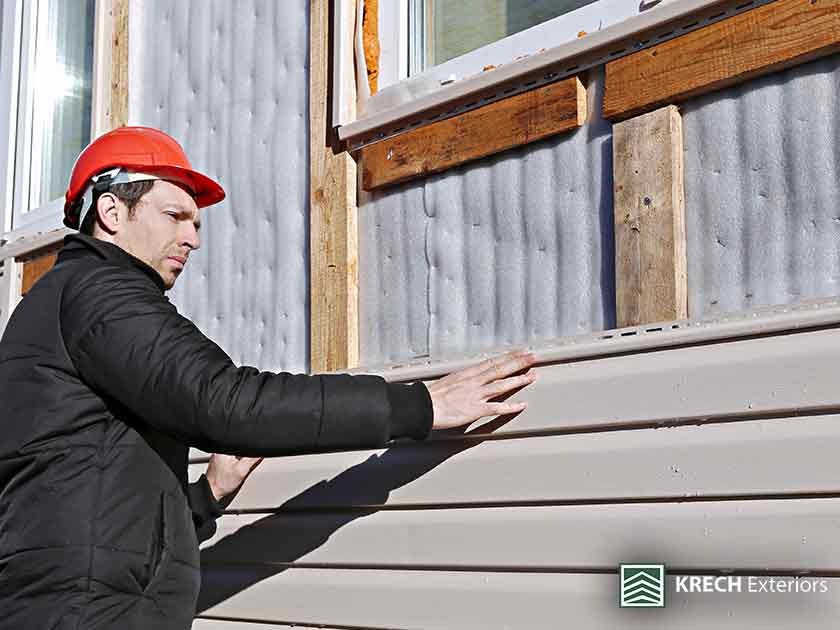The Important Guide to the Various Kinds Of Siding and Their One-of-a-kind Benefits
In the realm of home renovation, picking the ideal house siding is an essential choice that impacts both visual appeal and functional efficiency. With so numerous options to take into consideration, which home siding material really stands out for your particular task?
Timber Siding
Wood exterior siding, a popular option for property outsides, supplies a timeless aesthetic that combines natural elegance with architectural honesty. This exterior siding product is readily available in numerous styles, including clapboard, tiles, and board-and-batten, enabling homeowners to tailor their façade to match their layout preferences. Timber home siding is normally crafted from resilient species such as cedar, redwood, or pine, which are known for their strength and capability to withstand ecological stressors.
Among the primary advantages of wood house siding is its outstanding insulation homes, which can contribute to power efficiency and reduced heating prices. Furthermore, wood house siding is eco-friendly, making it an environmentally pleasant choice when sourced sustainably. Routine maintenance, consisting of painting or discoloration, can prolong its life-span and improve its look, permitting house owners to preserve the all-natural appeal of the wood.
Nonetheless, potential drawbacks consist of vulnerability to insects, rot, and weather damages, necessitating ample treatment and maintenance - morris siding contractor. In spite of these issues, when properly looked after, timber house siding can offer a long lasting and beautiful remedy that enhances the personality of a home while offering a warm, inviting environment

Plastic Exterior Siding
Plastic house siding has emerged as a leading selection for home owners seeking a low-maintenance outside choice that incorporates longevity and cost. This flexible product is crafted from polyvinyl chloride (PVC), making it resistant to numerous climate condition, including dampness and UV rays. Consequently, plastic exterior siding does not warp, rot, or discolor, ensuring resilient aesthetic allure.
One of the main advantages of plastic house siding is its comprehensive variety of designs and shades, enabling property owners to attain the desired search for their residential or commercial property without the demand for constant repainting. Additionally, vinyl home siding is easy to set up, which can dramatically reduce labor expenses during building and construction or renovation projects.
Vinyl home siding additionally adds to power efficiency. Numerous options function insulation support, which boosts thermal performance, helping to maintain comfortable indoor temperatures and potentially reducing energy costs. Moreover, its smooth surface area assists in very easy cleansing, calling for just routine cleaning with a yard pipe to eliminate dust and particles.
Fiber Cement Exterior Siding
Fiber cement siding has gained grip amongst contractors and property owners alike due to its remarkable combination of resilience and aesthetic versatility. Made up of a mixture of sand, cellulose, and cement fibers, this siding option is engineered to endure severe climate condition, consisting of high winds, hefty rainfall, and temperature level fluctuations, making it a lasting choice for property outsides.

Among the main advantages of fiber concrete siding is its resistance to parasites, such as termites, and its non-combustible nature, offering enhanced fire safety and security. morris siding contractor. In addition, it is offered in a broad selection of colors, designs, and textures, enabling homeowners to achieve their wanted visual without sacrificing performance
One more benefit is its low maintenance demands; fiber concrete house siding normally calls for painting or staining every 5-10 years, which is less regular than other materials. Moreover, its long life adds to a reduced overall expense of possession, as it lowers the need for regular fixings or replacements.
Eventually, fiber cement home siding stands for a superb financial investment for those looking for a resistant, eye-catching, and flexible outside alternative, incorporating both kind and feature to improve the home's visual charm.
Metal Home Siding
The appeal of metal home siding depends on its durable longevity and modern-day visual charm, making it a preferred choice for contemporary style. Readily available in materials such as aluminum and steel, metal house siding supplies a variety of surfaces and colors, enabling property owners to attain a tailored appearance that matches their layout vision.

Power performance is another significant benefit, as many steel siding items are designed with insulation alternatives that aid manage interior temperatures. This can cause minimized energy expenses in time. Furthermore, metal exterior siding is typically recyclable, making it an eco pleasant option for sustainability-minded property owners.
The installation process for steel house siding can be reasonably simple, leading to a quicker turnaround time for building and construction tasks. Generally, steel home siding integrates performance and style, making it a practical alternative for blog those looking for a aesthetically enticing and long-lasting outside finish.
Block and Rock Home Siding
Brick and rock home siding sticks out as an ageless choice that boosts the visual charm of any kind of home. Understood for their toughness and low upkeep, these products offer a phenomenal roi while raising the building's visual appeal. Readily available in numerous shades, textures, and patterns, block and rock can be tailored to match diverse building styles, from standard to modern-day.
One of the key my website advantages of block and stone home siding is their power efficiency. Both materials possess natural shielding homes that help regulate interior temperature levels, potentially reducing cooling and heating expenses. Additionally, they supply remarkable fire resistance contrasted to other siding choices, adding to boosted safety.
Another benefit is their long life. Brick and stone can last for decades, typically calling for marginal maintenance past periodic cleansing. Unlike timber house siding, they are impervious to pests and rot, ensuring a lasting exterior that withstands the elements.
Final Thought
In summary, the option of exterior siding significantly influences a home's aesthetic allure, power efficiency, and upkeep demands. Each kind of home siding-- whether wood, plastic, fiber metal, concrete, or block and stone-- uses distinct advantages tailored to various homeowner choices and ecological conditions.
One of the key advantages of wood siding is its excellent insulation residential properties, which can contribute to power efficiency and reduced home heating costs. Furthermore, timber siding is naturally degradable, making it an eco friendly choice when sourced sustainably.One of the main advantages of metal exterior siding is its resistance to numerous ecological elements.Power effectiveness is one more More Bonuses substantial benefit, as many metal siding items are made with insulation options that help control indoor temperature levels. Each kind of house siding-- whether wood, vinyl, fiber steel, block, or concrete and stone-- supplies unique benefits customized to numerous homeowner choices and ecological conditions.